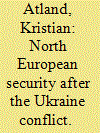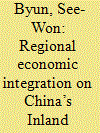|
|
|
Sort Order |
|
|
|
Items / Page
|
|
|
|
|
|
|
| Srl | Item |
| 1 |
ID:
145167


|
|
|
|
|
| Summary/Abstract |
Russia’s illegal occupation and annexation of the Crimean peninsula in February–March 2014, and the country’s well-documented involvement in the separatist conflict in Eastern Ukraine, have led to a significant worsening of Russia’s relations with the West. Vladimir Putin’s move to redraw Russia’s southern borders through the use of military force and subversive measures has given rise to an uncertainty that goes well beyond the post-Soviet space. Since 2014, North Atlantic Treaty Organization (NATO) has had to reassess many aspects of its relationship with Russia. The alliance has also initiated various measures to strengthen the military security of its eastern member states, particularly the Baltic states, Poland, and Romania. Further to the North, NATO’s northernmost member – Norway – is following developments in Russia with a heightened sense of awareness. The same goes for non-aligned Sweden and Finland, which are trying to adapt to the emerging, and increasingly complex, security environment in Northern Europe.
|
|
|
|
|
|
|
|
|
|
|
|
|
|
|
|
| 2 |
ID:
189255


|
|
|
|
|
| Summary/Abstract |
Why has China’s economic integration with Asia lagged in the northeast despite high expectations since the 1990s? China-centered integration in Asia is best understood at the Chinese subnational level. The interaction of central, local, and international interests under given structural and historical conditions produces distinct provincial trajectories of foreign economic engagement. While central state interests dictate policy choice under authoritarian rule, policy outcomes are shaped through local feedback effects and institutional innovations to manage transnational exchange. The Jilin-Northeast Asia case over the past two decades shows a negative orientation of such dynamics, stemming from a poor alignment of interests, the region’s structural constraints, and a socialist historical legacy. By tracing change and continuity on China’s late-developing, inland periphery, this study points to the subnational dimensions of cross-border integration obscured by conventional international relations scholarship, and presents the other side of China’s coastal success story. China’s ongoing plans for Asian integration are linked to the long-term development of China’s own regions rather than just aspirations abroad.
|
|
|
|
|
|
|
|
|
|
|
|
|
|
|
|
| 3 |
ID:
138982


|
|
|
|
|
| Summary/Abstract |
Recent discussion in critical border studies has reaffirmed the validity and necessity of multiperspectival approaches which move beyond state-centric outlooks to include diverse viewpoints of people at or on borders. One understudied aspect of everyday border life involves how international development organisations fit within wider dynamics of cross-border activities. Drawing upon experiences of development projects at a key border crossing between Kenya and Uganda, I explore (1) how perceptions of risk and danger contribute to constructions of the border towns as places in need of development interventions, and (2) how this border also adds to practical and logistical concerns already held by development organisations as they deliver these interventions. I argue that the place-based mix of location, material forms, and perceptions or practices impacts how ‘inter-national development’ is rationalised in border regions.
|
|
|
|
|
|
|
|
|
|
|
|
|
|
|
|
| 4 |
ID:
129271


|
|
|
|
|
| Publication |
2012.
|
| Summary/Abstract |
Reporters were informed at a press conference held by the Xinjiang Uighur Autonomous Region Party Committee's Office of the Human Resources Development Leading Group that the Xinjiang Uighur Autonomous Region Mid- and Long-Term Talent Development Program (2010-20) (hereinafter referred to as the "talent program") has, with approval from the regional party committee and the regional people's government, been officially promulgated. The talent program is the Xinjiang Uighur Autonomous Region's first mid- and long-term human resources development program and constitutes an important guiding document for the autonomous region's human resources development work today and for some time to come. The formulation and implementation of the talent program is an important measure for implementing the scientific concept of development and for better implementing the "strong human resources region" strategy (rencaiqiangqu zhanlue); it is an inevitable requirement for implementing the overall strategic dispositions to "build a stable and prosperous Xinjiang, bring prosperity to its people, and consolidate the border regions" and for bringing about scientific leaps forward and "enabling latecomers to catch up and surpass"; and it is of enormous significance for enhancing self-development capacities, coping with the strategic options of increasingly fierce international and domestic competition, accelerating Xinjiang's leapfrog advances and long-term stability, and achieving the goal of building a moderately prosperous society
|
|
|
|
|
|
|
|
|
|
|
|
|
|
|
|
|
|
|
|
|